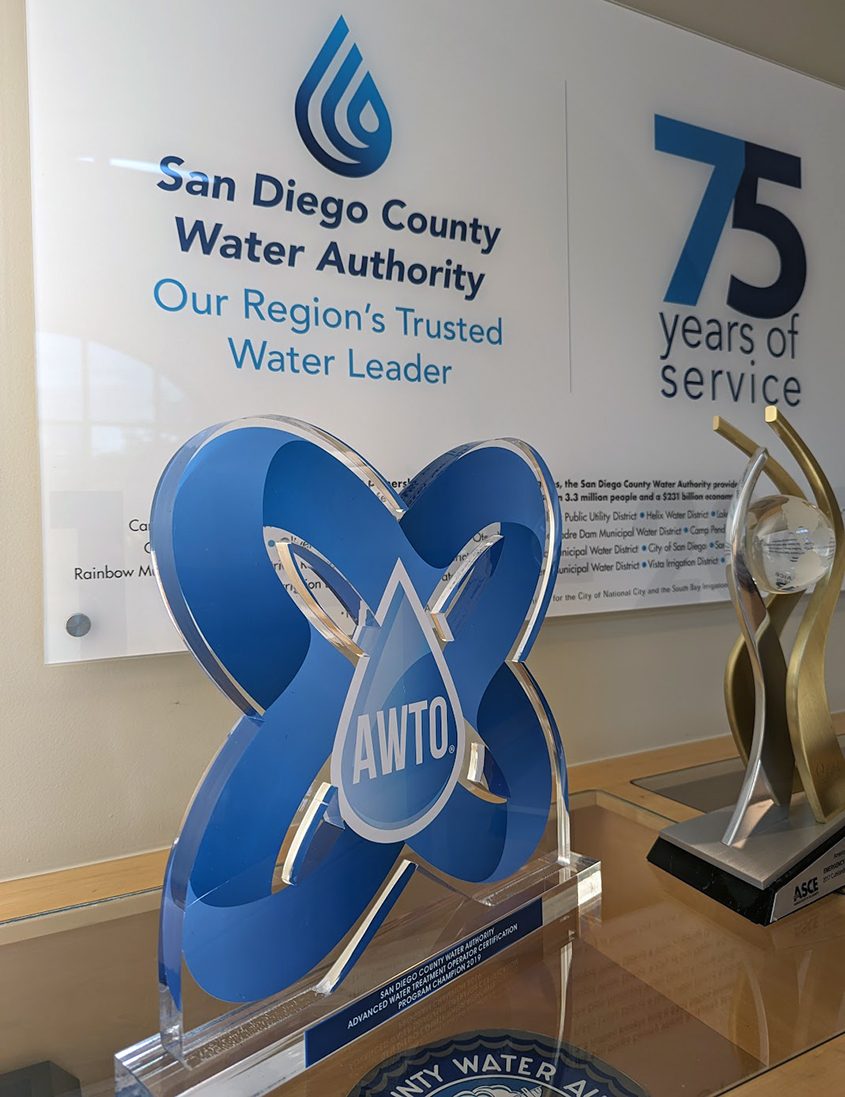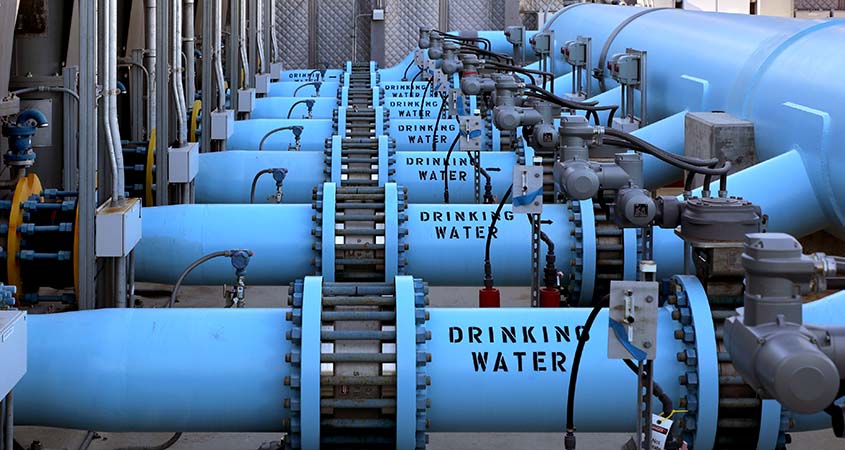EMWD Interview Talks Groundwater Desalination
In the latest episode of Dropping By from Stormwater Solutions, Joe Mouawad, general manager of the Eastern Municipal Water District (EMWD) talks about EMWD’s emphasis on groundwater desalination.
In the latest episode of Dropping By from Stormwater Solutions, Joe Mouawad, general manager of the Eastern Municipal Water District (EMWD) talks about EMWD’s emphasis on groundwater desalination.
As the world grapples with rising water use and climate-fueled drought, countries from the United States to Israel to Australia are building huge desalination plants to bolster their water supplies. These plants can create water for thousands of households by extracting the salt from ocean water, but they have also drawn harsh criticism from many environmental groups:
Former Arizona Gov. Doug Ducey’s multi-billion dollar plan for a desalination plant or other hugely expensive project to add to the desert state’s imperiled water supply is still alive and has the support of his successor despite a budget crunch that will crimp funding needed to get a project built.
The California Water Environment Association (CWEA) and the California-Nevada Section of the American Water Works Association (CA-NV AWWA) recognized the San Diego County Water Authority’s leadership and support of setting training standards and establishing training programs for water and wastewater industry professionals.
Chuck Greely, president of CWEA, and Sue Mosburg, executive director of CA-NV-AWWA, presented the Advanced Water Treatment Champion award at the November Board of Directors meeting.
“Your involvement from the very beginning of the Advanced Water Treatment Operator Certification program has allowed CWAA and California-Nevada AWWA to train and certify hundreds of California’s best operators, ensuring they have the knowledge and skills to produce the cleanest water possible,” said Greely.
“Thank you for what you’ve done in California. Thank you for bringing the water operator professional to the next level,” added Mosburg.
To date, 60 water industry professionals have completed the AWTO training and received certification.

The Advanced Water Treatment Champion award presented to the San Diego County Water Authority for its leadership in developing the Advanced Water Treatment Operator training certificate. Photo: San Diego County Water Authority
Prompted by calls in 2014 from water utilities, water professionals and the California State Water Board, a diverse set of stakeholders and experts including the Water Authority contributed their perspectives on the development of the certification. They were supported by CWEA and CA-NV AWWA staff and experts in exam development. Observers from the California State Water Board participated throughout.
Over 100 volunteers from CA-NV AWWA and CWEA were involved in planning, subject matter expert workshops, exam development, marketing and administering the new program. After four years, the Advanced Water Treatment Operator™ (AWTO®) certification was launched in 2020.
AWTO certification allows water and wastewater operators to demonstrate their advanced knowledge and qualify for new career opportunities at high-tech water reuse facilities. As California and Nevada expand water reuse, AWT operators are expected to be in high demand. There are currently 11 advanced water treatment facilities permitted and operating in California. Seven more are currently awaiting approval in the State of California’s permitting process.
Water and wastewater operators can get ready for these new career opportunities by getting AWTO certified today.
“As more potable reuse facilities start up in San Diego and across the state, this is a watershed moment in California history. We are securing water supplies for generations to come,” said Greely.
“We are well into the next decade of water and wastewater operations, and everyone in our industry plays an important role leading the way toward sustainability,” said Mosburg. “We are building the future now. We need this new supply and a new way of thinking about water before the next drought hits.”
Desalination facilities have critics who claim it’s too expensive and environmentally destructive, but there are supporters who want to make existing reverse osmosis technology better and many new ideas are being tested here in Southern California.
In the early 1990s, San Diego was dying on the vine, starved of water in a series of years long droughts.
The county, which relied almost entirely on imported water, had to cut back on 30% of its usage and was at risk of losing 50%.
At the last minute, a miracle saved San Diego — rain and snow in the desert replenished aquifers, saving the city from intense cutbacks.
But the water didn’t extinguish the passion of San Diegans, who after finding themselves in this situation, rallied together to find a way to become more self-sufficient, Jeremy Crutchfield, the water-resources manager at the San Diego County Water Authority, told Insider.
Since almost completely running out of water in 2015, and again in 2021, the City of Fort Bragg is working to make sure it stays ahead of any future droughts by investing in desalination.
“We stopped allowing people to wash dishes and had them use paper products and things like that, just disposable plates and things like that. So it was very serious at that time,” Director of Public Works for the City of Fort Bragg John Smith said.
Thanks to a decades-long supply diversification strategy and continued efficient use of water across the region, the San Diego County Water Authority announced that the region has reliable supplies to meet demands in Water Year 2024, which started October 1.
Hydrologists use Oct. 1 to begin measuring the snow and rain that will help carry water users through dry summer months the following calendar year. This fall, El Niño conditions continue to strengthen and could bring above-average precipitation to Southern California. In a recent El Niño forecast by NOAA, there is a greater than 95% chance that El Niño continues across the Northern Hemisphere through the winter into 2024. The chance of a “strong” El Niño is 71%.
“San Diego County continues to have the water necessary to support our $268 billion economy and quality of life for 3.3 million residents,” said Mel Katz, chair of the Water Authority Board of Directors. “We are grateful for the reprieve from drought – but we recognize that dry times will return, probably sooner than later. We are ready when they do.”
Despite significant rain and snow over the past 12 months, longer-term trends indicate a hotter, drier Southwest climate. Across the arid Southwest, water agencies are spending billions of dollars to increase water supply reliability as they balance the costs of investments against the costs of not having enough water for homes and businesses.
Since the early 1990s, the Water Authority and its 24 member agencies have made major investments in supply reliability, including in the landmark conservation-based 2003 Quantification Settlement Agreement, which provides over half of the region’s water, the building of the nation’s largest seawater desalination plant, and in the maintaining and upgrading of water infrastructure. That strategy has paid off during dry times. Just one year ago, the situation was dramatically different in other parts of Southern California, as millions of residents were reduced to health and safety water rations – though regional investments meant the San Diego region was spared.
Compared to recent years, the new water year begins with improved supply conditions at the Water Authority’s two imported water sources – the Colorado River and the Sierra Nevada. On the Colorado River, a good water year and conservation efforts raised storage levels, prompting the U.S. Bureau of Reclamation to declare that California will not face supply restrictions through 2024.
Meanwhile, in Northern California, Lake Oroville and San Luis Reservoir – two key State Water Project reservoirs – had 2.76 million more acre-feet in storage combined at the end of August 2023 compared to the prior August. (An acre-foot is approximately 325,900 gallons, or enough water to meet the annual needs of three typical single-family households.)

The San Diego County Water Authority added desalinated seawater to its supply portfolio in 2015 with the start of commercial operations at the nation’s largest seawater desalination plant. Photo: San Diego County Water Authority
In the San Diego region, water users also benefit from the Claude “Bud” Lewis Carlsbad Desalination Plant, as well as increased water storage levels in many local reservoirs. At the end of August 2023, member agency local storage was up 137,400 acre-feet, or 80%, compared to the same time in 2022. Meanwhile, the Water Authority had approximately 100,000 acre-feet available in emergency and carryover storage. This represents emergency storage for up to six-months and carryover storage to minimize or avoid potential supply cutbacks during periods of drought or other supply shortage events.
The San Diego County Water Authority says higher than expected rainfall amounts and an anticipated El Niño are keeping levels high.
The outlook for the upcoming water year in San Diego County is good, in terms of supply, the County Water Authority said, but that doesn’t mean San Diegans should decrease their conservation efforts.
Efren Lopez, a water resources specialist with the County Water Authority, told ABC 10News that water supply for the county looks good for 2024 in comparison to 2023, when the state was dealing with a severe drought.
But then things turned around.